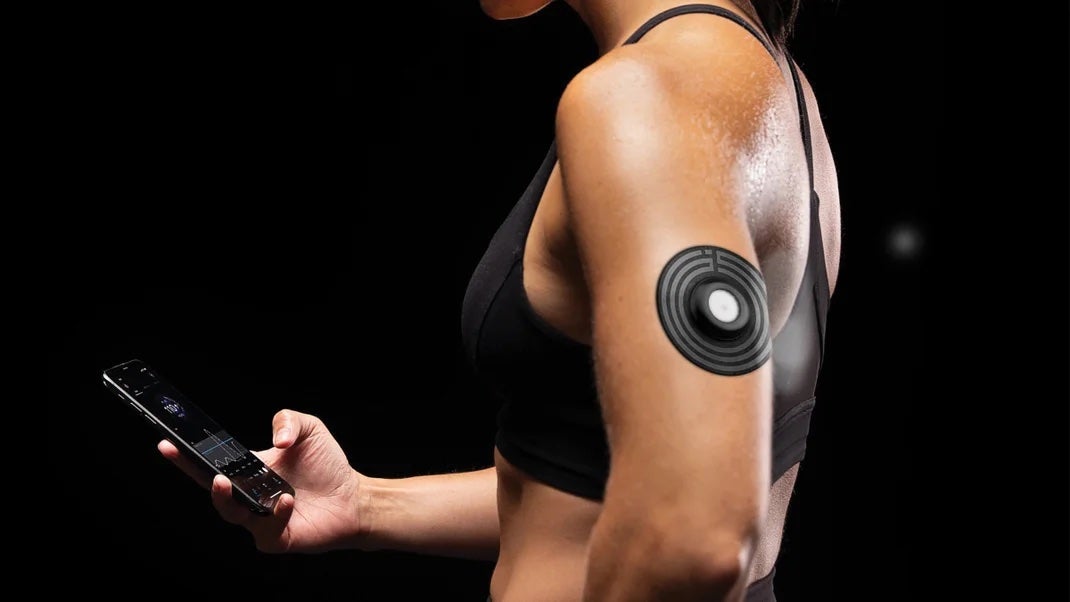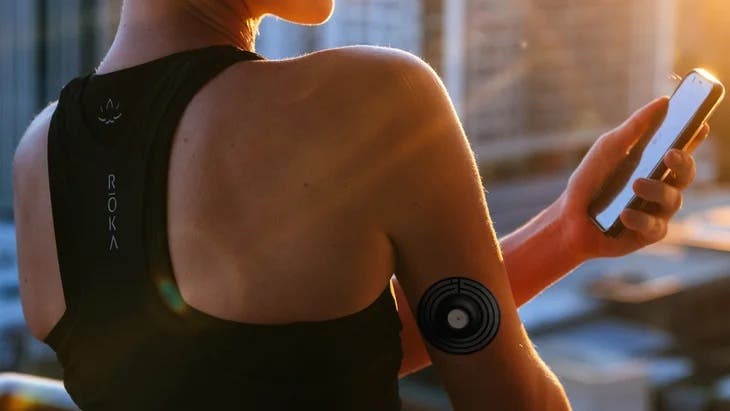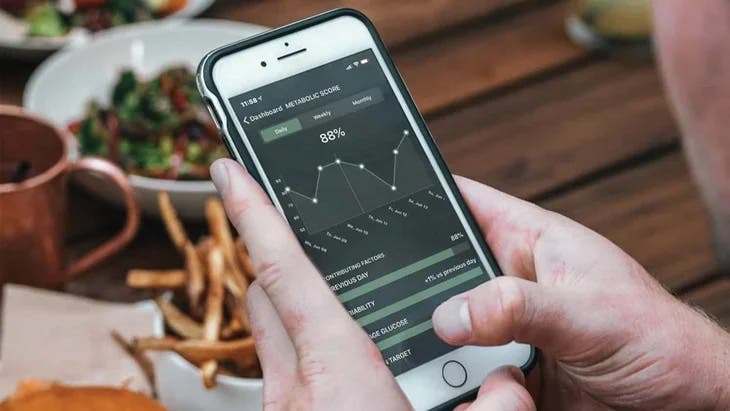Can Tech Help You Hack Your Nutrition—and Supercharge Running Performance?

(Photo: Courtesy Supersapiens)
Runners are always measuring themselves: how fast were your splits, how far did you go, how high was your heart rate, how did that affect your VO2 max or your lactate threshold, and so on. While consumer fitness trackers have been around to help runners quantify performance since the first Fitbit debuted in 2009, tracking nutrition has mostly consisted of counting calories. But now, at-home testing devices and wearables are bringing the kind of specialized nutrition testing that was once left to elite athletes or those with metabolic issues to everyday exercisers.
That’s a good thing, says Sara Schaefer, Ph.D., chief nutrition scientist at Nutrilogic, who has studied nutrition tracking devices. “We have an epidemic in our country where people’s health is unmanaged,” she says. “People have not been empowered to take control of their health—they rely on their doctors for everything. These nutrition tracking devices allow people to take back that control when they use them as a tool to learn about and engage in healthy behaviors.”
There are blood and DNA tests that measure everything from your hormones to hemoglobin; pee sticks that analyze current hydration and nutrient levels; smart patches—noninvasive sensors—that stick to the skin and monitor temperature, heart rate, blood sugar, and other vital statistics; and devices that measure your metabolism.
The common thread between all of these: knowledge. “Runners are really looking to maximize performance in any way possible,” says Stephanie Howe, Ph.D., a sports nutritionist, coach, and ultrarunner. “Any time you learn something more about yourself that could potentially impact your performance, that’s attractive, right? And that’s what these devices claim to do.”
In a lot of cases, this kind of education is simply about engagement. “When you’re looking at your metrics and how they’re changing from day to day, you’re understanding how different inputs affect your body,” says Schaefer.
Tracking nutrition in this way could potentially help you identify areas that could improve performance or issues that could be holding you back. An iron deficiency, for example, could mean your muscles aren’t getting enough oxygen, which would make running feel harder; inadequate vitamin D and calcium levels could lead to stress fractures; and low B12 levels could compromise endurance and cause overall fatigue and weakness.
RELATED: 5 Running Nutrition Myths To Bust Right Now.
As the saying goes, you are what you eat—and your diet doesn’t just directly affect how you perform, it influences things like mood and sleep, which play a huge role in how you feel when you hit the road. Understanding how all those factors come together can help you unlock your potential. “The more information you can collect on your health, the better informed you are,” says Schaefer.
Can You Trust Your Tracker?
How accurate or reliable these devices are is still very much up in the air. Schaefer contributed to a 2020 study in the journal JMIR mHealth and uHealth where researchers used a nutrition tracking wristband and partner app to monitor nutritional intake. They found there was a high variability in the accuracy and utility of the sensor. But most of these newer devices simply haven’t been studied yet.

When you’re talking about a lab-based blood test like InsideTracker, the science is the same as if you did your testing through a place like LabCorp or Quest Diagnostics; the only difference is in how you’re providing the sample.
A continuous glucose monitor like Levels can also be informative; the company uses an Abbot continuous glucose monitor based on a sensor originally developed for people living with diabetes and only available by prescription. (Eliud Kipchoge wore a non-prescription, sport-specific version of an Abbot sensor – Libre Sense Glucose Sport Biosensor – with the accompanying Supersapiens app, while training for and competing in the NN Mission Marathon before this summer’s Tokyo Games). In non-diabetic users, CGM-derived glucose measurements corresponded with blood glucose levels, according to a 2015 study published in PLOS One.
Beyond that, marketing may be outpacing science. Right now, “it’s up to the companies to validate these devices,” says Schaefer. But you can do your own due diligence by vetting companies before you invest. When you’re considering something that may influence your lifestyle decisions, you should be looking for published, peer-reviewed studies and valid clinical trials done on any products. Who’s behind the product matters, too: “Is it their team engineers who are just putting together an algorithm, or does it include doctors, physicians, people that know about bioscience, bioengineers? That’s really important,” says Schaefer.
RELATED: There’s No Space For “Guilt” In Endurance Fueling
Even if you’ve vetted a company and trust their product, the results are where things can get tricky. When you’re working with a doctor, they know your medical history and can provide feedback based on that; a device and app (even if it’s overseen by physicians) will never be as diagnostic. “The best way to learn about yourself is to work with someone who has the training and the knowledge to know how the body works and can give you insights based on that,” says Howe.
That’s not to say you can’t benefit from using nutrition trackers (especially if you have the money to spare). Even if they’re not perfect, you can still use them to work with your own baseline. Think of it like a clinical trial where you’re the entire trial—it’s more about tracking trends and patterns in your own data than wondering how you compare to a data point pulled from a much larger population.
Never Let a Tracker Run Your Life
The one major issue with nutrition trackers is how the consumer uses them. A lot of trackers cause people to override their own body’s cues in favor of data from an app. Just like fitness trackers, nutrition trackers are based on averaged data points. Picture a nutrition label on the back of a box of food—those numbers are based on a 2,000-calorie per day diet, but that’s actually the absolute minimum most female athletes should be consuming. While fitness trackers use scientifically determined healthy ranges, nutrition is also personal with a lot variables, and that leaves room for error if you don’t listen to your body.
“You can’t treat your body like a calculator, and I think a lot of these devices are trying to do that,” says Howe. In some cases, their information may be reliable, but they may not be measuring anything that will actually affect your performance. “More information isn’t always better,” she adds. Certain things, like knowing your sweat rate during a workout, can aid in dialing in a hydration plan, but unless you’re suffering from a metabolic disorder or other condition, other metrics can just be extraneous information that overcomplicates things to the point where you’re no longer connected to your own body.
And, just like with fitness tracking, there is a danger in veering toward obsessive tracking tendencies that could potentially lead to disordered habits. While research hasn’t yet been done on the mental effects of nutrition trackers, people who tracked calories on a smartphone application showed higher levels of disordered eating, a 2017 study in the journal Eating Behaviors found. The researchers suggested that monitoring an individual’s caloric intake on a device such as an app might intensify the rigidity associated with calorie counting. That same theory could apply to glucose levels, hydration, and other dietary biometrics.
“It’s like orthorexia, or an unhealthy focus on eating in a healthy way,” says Howe. “You’re no longer trusting your intuition, and instead you could be relying on potentially misleading information from devices that aren’t science-backed, and it can create all this anxiety and stress around something that should be easy enough to do without technology.”
Are These Devices Worth the Investment?
Knowledge may be power, but a pricey tracker (most of these require you spend hundreds of dollars) isn’t the only way to educate yourself. While data can provide you with certain insights, your body itself is actually the best tracker. Think about it this way: If you’re tired, chances are, you don’t need a device to tell you that you need a better night’s sleep. The same goes for nutrients: “You can learn a lot by just paying attention to your body and how it reacts to certain foods,” says Howe.
And while a lot of these devices make nutrition tracking seem simple, the premise behind them might be so simple you don’t even need tech. Take hydration tracking. You probably already know the easiest clue is in your own urine: If it’s clear, you’re good, but the darker the color, the more dehydrated you are. To figure out how much fluid you lose during a workout, weigh yourself beforehand, run for an hour (keeping track of how many ounces you drink throughout), weigh yourself post-workout, then subtract that number from your pre-run weight, plus your fluid intake during the run, to find your individual sweat rate.
The point being, none of these are a magic bullet or quick fix for optimized nutrition. If any of them help you find a system that keeps your body in harmony and allows you to effectively manage your health, that’s great, says Schaefer. But if you have real concerns regarding your diet and want guidance, find a registered dietitian or a sports nutritionist who can help point you in the right direction—with or without data from nutrition trackers.
RELATED: Our Chef’s Favorite Weeknight Meal For Athletes
Nutrition Tech
Levels
Runners rely on glucose to fuel their muscles with enough energy to go the distance (it’s how you avoid bonking). This continuous glucose monitor—the same kind that’s been used for years by diabetics to manage their condition—uses a small sensor stuck into your upper arm to monitor your blood sugar levels 24/7, then syncs with a partner app on your phone. When you log a meal or exercise in the app, it automatically captures the increase in glucose, how high it peaks, and how long it takes to return to baseline; using those metrics, the app generates a score on a 1 to 10 scale, where lower numbers correspond to higher glucose spikes and higher numbers correspond to the opposite. Then, you can use those insights to adjust your habits to better fuel your goals. $399 for one month

Supersapiens
The next big thing for endurance sports is almost certainly going to be constant glucose monitoring (CGM), which allows athletes to track their blood glucose throughout the day and while training to better understand what foods and activities affect glucose levels (and, to some extent, energy levels). Supersapiens’ tech involves first “installing” the sensor yourself, driving a small needle into your tricep. The needle deposits a small filament about the thickness of a beard hair into your arm and is covered by a patch. The filament detects your blood glucose and transmits it live via Bluetooth to your smartphone and some compatible Garmin devices. The data tell you live glucose numbers, graphs, trends, variability, time in “zone,” and the app allows you to catalog your foods and activities. $150
Gatorade Gx Sweat Patch
Can you feel that crust of salt on your face after a run, or do you just look like you jumped in a pool? These one-time use sweat patches from Gatorade use a lab-based sweat testing protocol—developed by the Gatorade Sports Science Institute—to test fluid lost during a workout, sweat rate over the course of an hour, and the amount of sodium lost through sweat under certain workout conditions. Stick the tracker on your inner left arm before a run, then use your phone camera to scan the patch into the Gx app when you’re done. The app will show you your stats and translate that data into a sweat profile with personalized insights—like when to consume carbs or how much to drink before a workout—that can help you fuel better for future runs. $25 for two
Lumen
Inspired by pricey lab technology, this Bluetooth-connected device—which looks a bit like a fat vape pen—measures your metabolism by calculating the carbon dioxide concentration in your breath. You’ll inhale steadily through the device, hold your breath for 10 seconds, exhale steadily into the device, then repeat that cycle two or three times. Once the Lumen has enough data, it tells you whether you’re burning mostly fat or mostly carbs (in the a.m., you generally want to be burning fat; before a workout, you want to know your body is still running off carbs). The app also generates a daily nutrition plan for you, suggesting low-, medium-, or high-carb foods complete with meal ideas. The point is to improve your metabolism by helping your body more efficiently shift between using carbs and fats as fuel, which can improve your insulin sensitivity and make your blood glucose levels more consistent to optimize performance. $399
Vessel
How often do you get a blood test to check your nutrient levels—maybe once a year? This at-home urine test makes it possible to check as often as once a week. Instead of peeing in a cup at the doctor’s office, you pee on the test strip, wait three minutes, then use your phone camera to scan it into the Vessel app. You’ll get results for 10 essential health metrics like stress, hydration, and nutrition (including biomarkers like vitamins B7, B9, C, magnesium, creatinine, and calcium). If there are any problem areas, you can click into each finding for dietary and lifestyle changes that will have the biggest impact—for example, increasing low levels of magnesium can have cardiovascular and metabolic benefits, while decreasing high levels of cortisol can improve your sleep and lower your blood sugar. $50/month
InsideTracker
This blood testing service measures up to 43 biomarkers and 261 genetic markers to provide personalized insights that can help you optimize your health and performance. You can visit a lab to get the bloodwork done or have a technician sent to your home, then InsideTracker will determine which biomarkers you’ve already optimized and which need work, as well as how your DNA plays into performance (like how much testosterone you produce or the hemoglobin level in your red blood cells). The company recently partnered with Garmin to integrate sleep and resting heart rate data into its results, so it can deliver even more personalized daily tips (like eating more fiber to combat lower than normal deep sleep, or taking fish oil to offset a higher than normal resting heart rate). Starts at $179
This story originally appeared on Women’s Running.